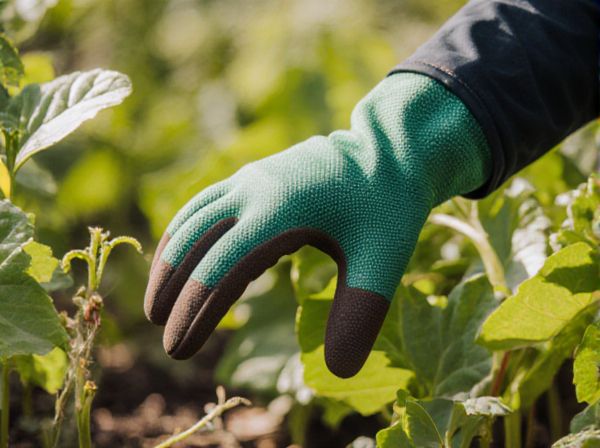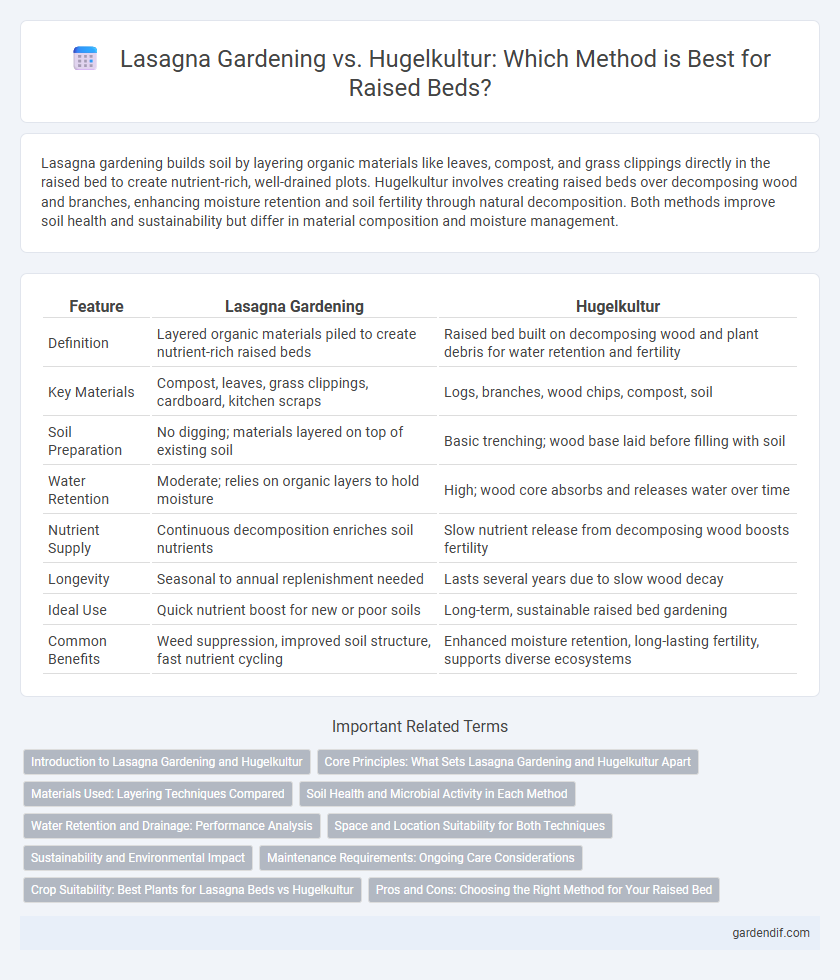
Lasagna gardening vs Hugelkultur Illustration
Lasagna gardening builds soil by layering organic materials like leaves, compost, and grass clippings directly in the raised bed to create nutrient-rich, well-drained plots. Hugelkultur involves creating raised beds over decomposing wood and branches, enhancing moisture retention and soil fertility through natural decomposition. Both methods improve soil health and sustainability but differ in material composition and moisture management.
Table of Comparison
| Feature | Lasagna Gardening | Hugelkultur |
|---|---|---|
| Definition | Layered organic materials piled to create nutrient-rich raised beds | Raised bed built on decomposing wood and plant debris for water retention and fertility |
| Key Materials | Compost, leaves, grass clippings, cardboard, kitchen scraps | Logs, branches, wood chips, compost, soil |
| Soil Preparation | No digging; materials layered on top of existing soil | Basic trenching; wood base laid before filling with soil |
| Water Retention | Moderate; relies on organic layers to hold moisture | High; wood core absorbs and releases water over time |
| Nutrient Supply | Continuous decomposition enriches soil nutrients | Slow nutrient release from decomposing wood boosts fertility |
| Longevity | Seasonal to annual replenishment needed | Lasts several years due to slow wood decay |
| Ideal Use | Quick nutrient boost for new or poor soils | Long-term, sustainable raised bed gardening |
| Common Benefits | Weed suppression, improved soil structure, fast nutrient cycling | Enhanced moisture retention, long-lasting fertility, supports diverse ecosystems |
Introduction to Lasagna Gardening and Hugelkultur
Lasagna gardening is a no-dig, organic gardening method that builds fertile soil by layering organic materials such as leaves, grass clippings, and compost, mimicking the nutrient-rich forest floor. Hugelkultur is a permaculture technique that creates raised beds by piling decaying wood and plant debris, enhancing water retention and soil fertility over time. Both methods improve soil structure and promote sustainable gardening through natural decomposition processes.
Core Principles: What Sets Lasagna Gardening and Hugelkultur Apart
Lasagna gardening relies on layering organic materials like compost, leaves, and grass clippings to build nutrient-rich soil, emphasizing decomposition and soil fertility. Hugelkultur centers on creating mounds using decaying wood and plant debris, prioritizing water retention and soil aeration through the wood's porous structure. The core distinction lies in lasagna gardening's flat, layered approach fostering gradual nutrient release, while hugelkultur's raised mounds promote moisture conservation and extended decomposition.
Materials Used: Layering Techniques Compared
Lasagna gardening uses alternating layers of organic materials such as compost, straw, grass clippings, and kitchen scraps, creating a nutrient-rich, no-dig raised bed that decomposes gradually. Hugelkultur incorporates large woody debris like logs and branches at its base, topped with smaller organic matter and soil, providing long-term moisture retention and microbial activity. The layering in lasagna gardening emphasizes quick decomposition and surface fertility, while hugelkultur focuses on building a raised mound with deep, slow-releasing nutrients from wood.
Soil Health and Microbial Activity in Each Method
Lasagna gardening enhances soil health by layering organic materials that decompose slowly, fostering rich microbial diversity and improving nutrient cycling. Hugelkultur promotes vigorous microbial activity through buried woody debris that retains moisture and creates anaerobic pockets, enriching soil with humus over time. Both methods boost soil fertility, but Lasagna gardening accelerates nutrient availability while Hugelkultur supports long-term soil structure and microbial habitat stability.
Water Retention and Drainage: Performance Analysis
Lasagna gardening excels in water retention due to its layered organic matter that absorbs and holds moisture effectively, ensuring consistent hydration for plants. Hugelkultur offers superior drainage by incorporating decomposing wood which creates air pockets, preventing waterlogging and promoting root aeration. Both methods enhance soil structure, but Lasagna gardening prioritizes moisture retention while Hugelkultur balances drainage with moderate water holding capacity.
Space and Location Suitability for Both Techniques
Lasagna gardening excels in small spaces and urban environments due to its layered organic materials that decompose in situ, requiring minimal soil depth and making it ideal for patios or limited garden plots. Hugelkultur demands more space and is suited for larger areas with ample sunlight, as it involves creating raised mounds from logs and woody debris that improve soil moisture retention and nutrient availability over time. Both techniques benefit from well-drained locations, but Lasagna gardening adapts better to confined spaces while Hugelkultur thrives in spacious, open settings.
Sustainability and Environmental Impact
Lasagna gardening enhances soil fertility by layering organic materials that decompose over time, promoting moisture retention and reducing the need for synthetic fertilizers, making it highly sustainable. Hugelkultur utilizes decomposing wood and organic matter to create self-watering raised beds, improving soil aeration and carbon sequestration while minimizing water usage. Both methods support environmental sustainability but Hugelkultur tends to have a greater impact on carbon storage and long-term soil health.
Maintenance Requirements: Ongoing Care Considerations
Lasagna gardening requires regular layering of organic materials like compost, leaves, and grass clippings, demanding consistent replenishment to maintain soil fertility and moisture levels. Hugelkultur involves decomposing wood logs buried beneath the soil, which reduces watering frequency due to its natural water retention but requires occasional monitoring for wood rot and pest control. Both methods benefit from mulching, but lasagna beds tend to need more frequent attention to layering compared to the longer-term stability offered by hugelkultur.
Crop Suitability: Best Plants for Lasagna Beds vs Hugelkultur
Lasagna gardening excels with shallow-rooted vegetables like lettuce, spinach, and herbs that benefit from its nutrient-rich, layered organic matter. Hugelkultur suits deep-rooted plants such as tomatoes, potatoes, and peppers that thrive in its raised, moisture-retentive woody mound structure. Understanding these crop preferences maximizes yield and soil health based on each method's unique decomposition process.
Pros and Cons: Choosing the Right Method for Your Raised Bed
Lasagna gardening offers rapid soil improvement through layered organic materials, promoting nutrient-rich, moisture-retentive beds ideal for quick planting cycles; however, it requires regular replenishment and may attract pests if not managed well. Hugelkultur builds long-term fertility by incorporating decaying wood that retains moisture and enhances soil aeration, but this method demands more initial space and time for decomposition before planting. Selecting between these techniques depends on your garden size, desired maintenance level, and planting timeline, balancing immediate yield against sustainable soil health.
Lasagna gardening vs Hugelkultur Infographic

 gardendif.com
gardendif.com